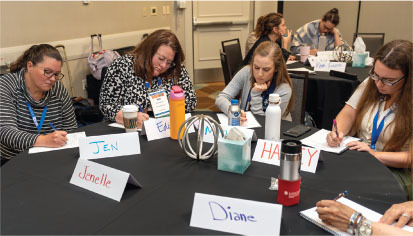November/December 2019
Leading Insight
Stage Fright Be Gone!
 For many people, regardless of profession, just the thought or mere mention of public speaking conjures up feelings of anxiety and fear.
For many people, regardless of profession, just the thought or mere mention of public speaking conjures up feelings of anxiety and fear.
Speaking in front of a crowd can be nerve-wracking for anyone; doing it effectively is another challenge in and of itself. But for engineers hoping to advance their careers, having strong presentation and public speaking skills vital; however, they are not learned overnight.
Melissa Marshall, an instructor in Penn State University’s Department of Communication Arts and Sciences and founder of the website Presentyourscience.com, helps scientists, engineers, and other technical professionals to improve their communication skills. As she says in a 2012 TED Talk, “Our scientists and engineers are the ones tackling our grandest challenges…. But if we don’t know about it and understand it, then their work isn’t done. So, scientists and engineers, please talk nerdy to us…. Make sure that we can see your science is sexy and that your engineering is engaging.”
Her six strategies that scientists and engineers can use while preparing a presentation are:
1. Be aware of your audience: “It is critical that you understand the background, knowledge base, interests, and biases of your audience so that you can adapt your content to them. Often, I will hear that the science needs to be ‘dumbed down.’ I think this is a flawed perspective that doesn’t place enough emphasis on the responsibility of the speaker to communicate clearly.”
2. Show the relevance: “It is important to establish early on why your work is relevant to your audience. If you don’t tell them why it matters to them, it is much harder to maintain their attention. Look for opportunities where you can create connections from your work to the everyday lives and experiences of your audience.”
3. Paint a picture: “Examples, stories, and analogies really help an audience to engage with your scientific content. The employment of these strategies can often be the difference between a good presentation and a great one. Examples and stories help technical information to ‘come alive’ for an audience.”
4. Make numbers meaningful: “There are many occasions in scientific presentations where the speaker must discuss elements of size and amount. Sometimes an audience might not fully appreciate the significance of a raw number or measurement. Your information can really stand out if you provide context.”
5. Banish bullet points: “When a speaker uses text-heavy, bulleted slides, it can lead to cognitive overload—otherwise known as Death by PowerPoint. Whether words are spoken or written, they are processed in the same part of the brain. Since a talk itself is composed of words, when a presenter has slides that are primarily text, the audience will often only read the slides or only listen to the presenter.”
6. Deliver dynamically: “Audiences have high expectations when it comes to delivery. While content is always the most important factor in any scientific presentation, the impact of delivery style is not to be underestimated. Think back to some of the best presentations that you have seen. The biggest must: Energy and enthusiasm for what you are presenting. Audiences connect with passionate speakers, so allow that to come through in your delivery.”
Robert Rabb, P.E., an associate professor and the mechanical engineering program director at The Citadel in Charleston, South Carolina, believes bridging the gap between analytical thinking and analytical communication has never been more important for engineering students and young engineering professionals.
According to Rabb, while conducting a needs-based assessment with engineering faculty at The Citadel in 2017, it was noted that engineering students struggled with producing conventional disciplinary documents as well as oral presentations, specifically distinguishing between broad information and “fine-grained details.”
Working with faculty teaching humanities courses, Rabb and others in the engineering department evaluated their curriculum and developed a writing and communication course that uses project-based learning (PBL) to teach sophomore engineering students skills like research presentation. The Citadel has since made the course mandatory for engineering students.
Since then, engineering faculty have used the lessons from the writing course to continue to develop those communication skills in more challenging courses.
For example, in a mechatronics course Rabb instructs, open-ended labs were developed to promote problem-solving and communication skills. Each team was given different components and ideas for a real-world application. In addition to writing about their design decisions and addressing each area, students had to brief their project to the entire class. Even though the other students had the same baseline knowledge as they did on the technical material, they had no previous knowledge of the application.
In a 2018 paper on the course, Rabb and English professor Alyson Eggleston wrote, “The team briefing the class had to be clear, succinct, and communicate their design and application to fellow engineers who had the opportunity to ask questions. Since the implementation of these PBL courses and techniques we’ve seen a drastic improvement in overall writing and presentation quality from our students.”


 Volunteering at NSPE is a great opportunity to grow your professional network and connect with other leaders in the field.
Volunteering at NSPE is a great opportunity to grow your professional network and connect with other leaders in the field. The National Society of Professional Engineers (NSPE) encourages you to explore the resources to cast your vote on election day:
The National Society of Professional Engineers (NSPE) encourages you to explore the resources to cast your vote on election day:




